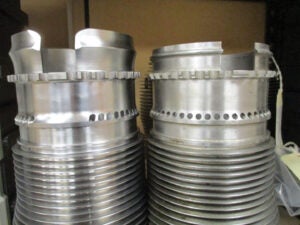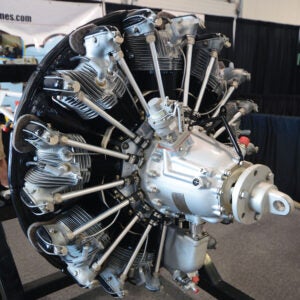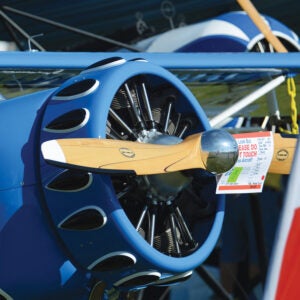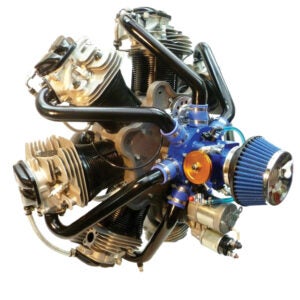
Classic Aero Machining Service
For those seeking the ultimate, authentic, full-gyroscopic WW-I rotary experience, New Zealand-based Classic Aero Machining (CAM) has been developing a brand-new-build Gnome Monosoupape engine for several years. It is a faithful rendition of the Gnome used in many French, English and German aircraft just prior to and during WW-I.
Besides the challenge of fully learning the nuances of this 100+-year-old design, CAM is dedicated to improving the Gnome while not detracting from its authenticity. A recent example is a prestart oil priming system (CAM found it had been taking 20 seconds for pressurized oil to reach the engine internals). Another is lengthening the lower portion of the cylinders for improved piston support. Also, the induction ports are now angled, promoting in-cylinder swirl for better fuel atomization and reduced plug fouling—a big help there. The in-cylinder motion is further aided by CAM’s fuel pump (the originals relied strictly on gravity). Purists may decry it, but CAM also has an electric starter for its rotary. It must be the first non-hand-propped rotary, but the engine runs cleaner and smoother than ever, and CAM has raised its power rating another 5 hp to a muscular 125 hp and nearly 600 pound-feet of torque while whirling at just 1120 rpm.

CAM emphasizes these engines are viable, reliable, real-world choices for WW-I replicas, and they’re in the rotary business for the long term. It certainly is the only new engine capable of delivering the true early bird rotary experience, which might be a little more performance-oriented than first imagined. CAM reports its rotary has a Sopwith Pup replica going 110 mph straight and level, plus 1000 fpm vertically. If you want to inspect a CAM rotary or need an airframe to match your new Gnome, KipAero in Dallas, Texas, works closely with CAM to build continuation WW-I Sopwiths.
CAM is part of the burgeoning replica and restoration scene in New Zealand and has a well-established business replicating various warbird parts, especially P-40 items.
Motorstar NA

Few homebuilts can take all the muscle a 621-cubic-inch M14P radial can dish out. But if you want a new $50,000+ version from builder Motorstar Romania, then Coy Aircraft Sales is also Motorstar NA and they can make it happen. Coy can also source a factory overhaul—now a fixed $21,500 if you have a core. That gets you the three-ring piston upgrade and Savarese ignition, along with overhauled air compressor, carburetor and oil pump, and test stand run-in—all work is done in Romania. The turnaround is 60 days and shipping is $3300.
A recent Motorstar development is trimming the M14P as a direct placement for the Nanchang CJ-6’s Huosai radial. This saves the owner much running around as such M14Ps come dressed with the correct fluid and pneumatic fittings.
Typically, when an M14P is overhauled, more often than not, it goes from the base 360 hp to the 400-hp M14PF upgrade as the price isn’t that much greater. Other sources for these robust Russian-designed radials are Jill Gemerzke’s M14P, Inc. in Kingman, Arizona, and Barrett Precision Engines, Inc. in Tulsa, Oklahoma, specializing in hot-rod versions with electronic ignition and Airflow Performance fuel injection.
Rotec Aerosport

Surprised to find radial engine fans in the 21st century are on the romantic side? No, and so radial maker Rotec’s comment that sales have been strong during the pandemic, with customers apparently in a hurry to get living after the initial COVID-19 shutdowns, also makes sense.
The naturally slow-turning and geared Rotecs provide the sound and long-prop appeal popular with builders looking for vintage appearance or simply seeking something a little different than the ubiquitous flat-engine norm. The engines remain unchanged for 2021.
Rotec offers two engines: the seven-cylinder R2800 good for 110 hp, and its big brother R3600 sporting nine of the same cylinders for a 150-hp rating. Both are un-supercharged. The smaller engine is most often paired with a fixed-pitch 76-inch-diameter prop, while the R3600, which was later to market but is proving the bestseller, can swing 90-inch blades.
Standard Rotec induction is a simple Bing carburetor. But Rotec’s own—and still quite simple—throttle-body fuel injection is optional. Its main attraction is staying on the job during aerobatics. And besides fitments for its radials, Rotec offers versions of its carburetor for everything from Volkswagen conversions to Rotax, Jabiru and even Lycomings. Rotec sells direct, so planning ahead for engine construction and freighting from Australia helps avoid frustration.
Verner Motor

By all accounts, Verner Motor is an up-and-coming small radial engine maker based in the Czech Republic. Its pocket-sized radials are torquey, long-prop friendly engines fitting well in the larger ultralight category plus smaller Experimental/Amateur-Built airframes. Hatz biplanes are a popular fitment, for example.
While Verner has multiple dealers in North America, Sam Watrous at ScaleBirds seems preeminent, likely due to the engine mounts, exhaust and other accessories he offers for Kitfoxes and the like. So it’s indicative of Verner’s increasing visibility that Watrous moved his booth at AirVenture from his traditional ultralight haunt to the more heavily traveled Experimental area in 2019.
For 2021 there are no changes to the five core engines. But Verner has discontinued its EFI and now offers the customer’s choice of a Marvel MA-4SPA or the Super G S&S carburetor with ThunderJet modifications. The Marvel-Schebler offers full mixture control; the S&S is a fixed-mixture aftermarket Harley-Davidson carburetor. Naturally, the S&S is less expensive than the Marvel-Schebler. That’s not a surprise. What might be is that the carburetors deliver more power than the fuel injection did, especially the Marvel-Schebler.
As expected, the Verner radials use the same two-valve, 3.62×4.02-inch cylinder but fit five, seven or nine of them as power needs rise. (Note the little 28-inch diameter three-banger shares its smaller cylinders—aluminum with steel liners—with a five-cylinder version as well.) All of the larger, more popular engines are relatively low-rpm, direct-drive designs using a carburetor and no supercharging. Designed to run on 93 octane U.S. or 95 octane European premium mogas, these Scarlett series engines have a 32-inch diameter and a TBO of 1000 hours. Experience shows some lead fouling on a steady diet of 100LL fuel. But this responds favorably to lead-scavenging additives or simply by running mogas. The TBO is expected to rise as experience is gained with higher-hour Verners. So far the company has sold about 150 engines worldwide. And while Watrous reports no issues, none have reached 1000 hours yet.
| Engine Model | Drive Type | Horsepower | Weight | Price |
|---|---|---|---|---|
| Classic Aero Machining Service | ||||
| Gnome Monosoupape | rotary | 125 hp @ 1125 rpm | 260 lb with oil pump, air pump, ignition | $62,000 |
| Motorstar NA | ||||
| M14P | geared | 360 hp @ 2900 rpm | 515 lb w/ air or electric start, B&C alternator | $52,000 |
| M14PF | geared | 400 hp @ 2900 rpm | 515 lb w/ air or electric start, B&C alternator | $55,000* |
| *28K–32K reman; $21,500 rebuild w/core | ||||
| Rotec Aerosport Pty Ltd | ||||
| R-2800 | geared | 110 hp @ 3600 rpm | 224 w/ starter, alternator, carb, ignition, stub exhaust | $22,500 |
| R-3600 | geared | 150 hp @ 3600 rpm | 275 w/ starter, alternator, carb, ignition, stub exhaust | $27,500 |
| Verner Motor | ||||
| Scarlett Radial 3V, 100ci | direct | 42 hp @ 2500 rpm | 86 lb w/ starter, alternator, carb, ignition | $9,315 |
| Scarlett Radial 5V, 166ci | direct | 60 hp @ 2300 rpm | 119 lb w/ starter, alternator, carb, ignition | $10,925 |
| Scarlett Radial 5S, 207ci | direct | 83 hp @ 2200 rpm | 152 lb w/ starter, alternator, EFI, ignition | $15,815 |
| Scarlett Radial 7U, 290ci | direct | 124 hp @ 2300 rpm | 183 lb w/ starter, alternator, EFI, ignition | $20,415 |
| Scarlett Radial 9S, 372ci | direct | 158 hp @ 2400 rpm | 238 lb w/ starter, alternator, EFI, ignition | $25,710 |




